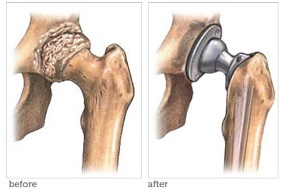Surgery may be the most important and intense step in any treatment plan, but it is not the only one that carries serious weight and particular risks. The recovery period following an orthopaedic surgery usually involves many important steps and processes that will determine your long-term health and mobility.
Jyoti Nursing Home in Jaipur provides total hip joint replacement which takes approximately two to four hours of surgical time. The preparation prior to surgery may take up additional time. After surgery, the patient is taken to a recovery room for immediate observation that generally lasts between one to four hours. The lower extremities will be closely observed for both adequate sensation and circulation. If unusual symptoms of numbness or tingling are noted by the patient, recovery room nurses are available and should be notified by the patient.
Hip Replacement surgery in Jaipur
During the immediate recovery period, patients are given intravenous fluids. Intravenous fluids are important to maintain a patient's electrolytes and replace any fluids lost during surgery. Antibiotics might be administered as well as pain medication. Patients also will notice tubes draining fluid from the surgical wound site. The amount and character of the drainage is important to the doctor and can be monitored closely by the nurse in attendance. A dressing is applied in the operating room and will remain in place for two to four days to be later changed by the attending surgeon and staff.
Pain-control medications are commonly given through a patient-controlled-analgesia (PCA) pump. Pain medications occasionally can cause nausea and vomiting. Antinausea medications may then be given.
Measures are taken to prevent blood clots in the lower extremities. Patients are placed in elastic hose (TEDs) after surgery. Compression stockings are often added, which help by forcing blood circulation in the legs. Patients are encouraged to actively exercise the lower extremities in order to mobilize venous blood in the lower extremities to prevent blood clots. Medications are often given to thin the blood in order to further prevent blood clots.
Immediately after surgery, patients are encouraged to frequently perform deep breathing and coughing in order to avoid lung congestion and the collapse of tiny airways in the lungs. Patients are also given a blow bottle whereby active blowing against resistance maintains the opening of the breathing passages.
Total Hip Replacement Recovery Tips can help you to have a smooth and successful recovery :
- Get in a healthy exercise routine
- Most hip replacement patients are able to walk within the same day or next day of surgery; most can resume normal routine activities within the first 3 to 6 weeks of their total hip replacement recovery. Once light activity becomes possible, it’s important to incorporate healthy exercise into your recovery program. Recommended activities include gradually increased walking and light household activities (sitting, standing, climbing stairs). Movement is essential to a healthy recovery.
- Pay attention to diet and weight
- Excess weight can put stress on your new hip prosthesis and increase wear and the risk of complication. Maintaining a healthy body weight before and after your surgery can help to improve your recovery process and the ultimate lifespan of your prosthesis. Additionally, make sure to maintain a balanced diet during your recovery.
- Exercise to Promote Blood Flow
- Certain exercises can help to promote blood flow and prevent clots. These include:
- Regularly squeezing the thigh and calf.
- Motion exercises for the legs that utilize full range of leg motions
- Walking with or without the assistance of supportive devices (such as walker/cane)
- Make household preparations
Side effects associated with hip replacement surgery may include :
- Blood clots : Clots can form in your leg veins after surgery. This can be dangerous because a piece of a clot can break off and travel to your lung, heart or rarely your brain. Your doctor may prescribe blood-thinning medications to reduce this risk.
- Infection : Infections can occur at the site of your incision and in the deeper tissue near your new hip. Most infections are treated with antibiotics, but a major infection near your prosthesis may require surgery to remove and replace the prosthesis.
- Fracture : During surgery, healthy portions of your hip joint may fracture. Sometimes the fractures are so small that they heal on their own, but larger fractures may need to be corrected with wires, pins, and possibly a metal plate or bone grafts.
- Dislocation : Certain positions can cause the ball of your new joint to become dislodged, particularly in the first few months after surgery. If the hip dislocates, your doctor may fit you with a brace to keep the hip in the correct position. If your hip keeps dislocating, surgery is often required to stabilize it.
- Change in leg length : Your surgeon takes steps to avoid the problem, but occasionally a new hip makes one leg longer or shorter than the other. Sometimes this is caused by a contracture of muscles surrounding the hip. In this case, progressively strengthening and stretching those muscles may help.
- Loosening : Although this complication is rare with newer implants, your new joint may not become solidly fixed to your bone or may loosen over time, causing pain in your hip. Surgery might be needed to fix the problem
